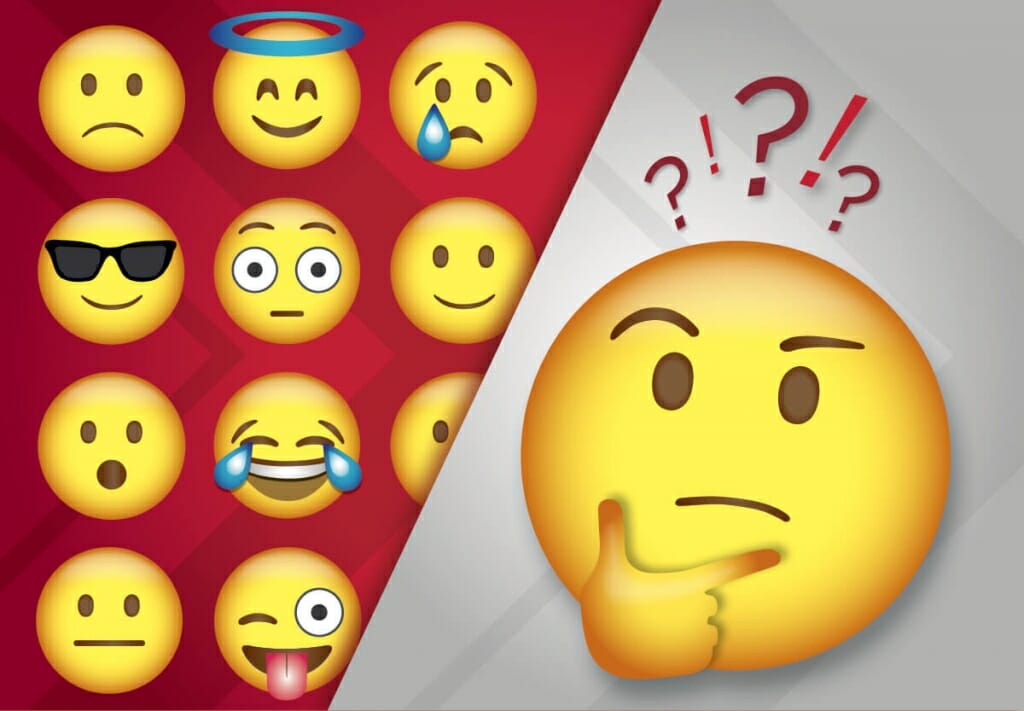Away with words: Emoji help brands communicate with customers
World Emoji Day was last week. But in today’s world filled with near-constant communication, every day is a celebration of emoji.
Sometimes an image of two girls dancing while wearing leotards and bunny ears conveys what you’re feeling in a way words never could. And when you’re done with a texting conversation, the thumbs-up emoji can be a real timesaver.
But for Joann Peck, emoji are serious business. Peck, an associate professor in the marketing department of the Wisconsin School of Business, along with co-authors from the University of Iowa and the University of Wisconsin–Whitewater, published “Textual paralanguage and its implications for marketing communications” in the Journal of Consumer Psychology. They continue to research textual paralanguage (TPL), which is nonverbal communication in text.
Emoji are an example. While many of us use them to make texting more fun, brands have discovered it’s a pretty good way to connect with customers.
Peck takes a break from emoji to answer a few questions using actual words.
Why did you start researching emoji?
Our research examines how meaning and emotion are conveyed in written communications, especially on social media. Face-to-face communication is rich with nonverbal behavior, including body language, eye contact and tone of voice. These elements of communication are often referred to as “paralanguage.”
When people exchange written messages electronically, these elements have to be translated into text to be communicated. We call these translations “textual paralanguage” or TPL. TPL is broader than emoji use. For example, “ I. guess. I’ll. go.” has a different meaning than ” I guess I’ll go” or “I GUESS I’LL GO.”
We propose that there are five broad types of TPL, which are related to the auditory, haptic (touch) and visual properties of communication. Auditory TPL has two components: voice quality and vocalizations.
Voice quality has to do with how words should be spoken, and includes elements of speech such as stress, pitch or rhythm. An example of a message that conveys voice qualities is “Best. Sale. Ever.” The rhythm of the message is indicated by the periods after each word.
Vocalizations are recognizable utterances or sounds that are produced by the body but are not necessarily English words. Examples include “sigh,” “umm,” and “haha.”
Haptic TPL consists of tactile kinesics, which are conveyed through the suggestion of physical contact with another individual. For example, *high five* suggests interpersonal touch between the sender and receiver of a message.
Visual TPL is comprised of visual kinesics and artifacts. Visual kinesics represent nonverbal communication related to movement of the body. Many facial emoji fall into this category, representing facial expressions and gestures. Artifacts are related to how the text-based message appears, including typeface, formatting and non-kinesic and non-tactile stickers and emoji, such as the emoji for a car.
We suspected that TPL is being widely used. In order to explore this, we collected data from Twitter, Facebook and Instagram to find out. In our sample, we found that 20.6 percent of brand tweets, 19.1 percent of Facebook posts, and 31.3 percent of Instagram posts contained TPL.
What has surprised you about your findings?
We originally thought that a brand using TPL would result in the brand seeming warmer and friendlier. This is not always the case. For example, one type of TPL is all caps. A brand yelling at you in all caps does not necessarily communicate friendliness.
Which brands know how to speak emoji well? What makes them fluent?
There is a lot of variability in how brands use TPL. Oreo is an example of a brand that seems to use TPL effectively. Often, there is an element of it being used in a clever way and humor is often part of successful TPL use.
Is there a danger of overuse?
We are finding that overuse may lead to a decrease in brand perceptions of competence. Use of TPL is usually associated with informality. If a brand is too informal, this can seem inappropriate to some consumers. And, there are brand categories that people expect will be more informal or formal. For example, fast food is a more informal category while banks are the reverse.
Do you think emoji are here to stay?
TPL is here to stay. TPL helps convey meaning in text, just as nonverbals do in face-to-face communication.
Do you use them in your everyday communication? If so, what was the last one you used?
 Yes, I use them in more informal communications, but not as much in more formal or professional situations (unless I am asked). Last one used: Smiley face.
Yes, I use them in more informal communications, but not as much in more formal or professional situations (unless I am asked). Last one used: Smiley face.
Do you have a favorite emoji?
I like the eye roll. Conveying sarcasm in text can be problematic as it may mistakenly be interpreted as meanness. Adding an eye roll helps the understanding of the meaning. The smiley face and hearts are classics.





